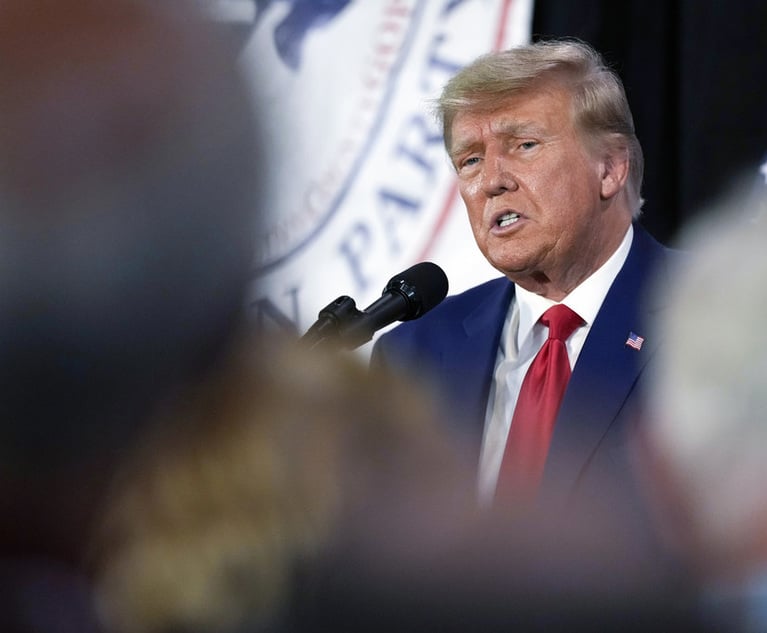Portrait Predicament
Director's oil portrait lands a museum board in hot water.
February 29, 2008 at 07:00 PM
4 minute read
Formal oil portraits of leaders are not associated with the non-profit sector. We usually associate them with the captains of industry who donate their money to non-profits, or with government officials such as governors and judges. These formally posed paintings hang in corporate boardrooms, country clubs, drawing rooms and state houses. You don't see them at the local food bank, and you don't want to.
This is because the symbolic weight–and cost–of an oil portrait is just too much for charities to bear. The very act of posing for an oil portrait is at odds with the inherent selflessness of the charitable impulse. The portrait's entire purpose is glorification of the individual. Unless you can persuade donors that the portrait's subject is the personification of Faith or Hope or better yet Charity, the donors will wonder how an oil painting advances the organization's mission. I, for one, can't think of how.
All the while, there is the subject of the portrait himself–usually a man. Either he wants the portrait because he thinks he deserves it or he accepts it because others importuned him. Regardless, he is engaged in an overtly egotistical act, and an expensive one. Both aspects of formal portraiture do not reside easily within the culture of most charities.
That's why the news that the Smithsonian's National Museum of the American Indian spent $48,500 on an oil portrait of the museum's recently retired founding director, W. Richard West Jr., got so much attention–including Congressional attention–in January and is still being talked about.
Congress provides about 70 percent of the Smithsonian's budget. West himself commissioned the 2005 portrait by New York artist Burton Silverman after consulting with some members of the museum's advisory board. Earlier reports that West had spent “lavishly” on travel were already generating negative publicity for the museum. And it was only last year that Smithsonian Secretary Lawrence M. Small resigned in disgrace over similar fancy expenditures. Sen. Charles Grassley (R-Iowa), who has become a rather effective one-man overseer of the non-profit sector in recent years, told the Board of Regents, “It appears that Mr. West was determined to meet Mr. Small's champagne lifestyle, glass for glass.” Ouch.
The senator's wry and biting observation was contained in a lengthy letter requesting five years of records of West's activities, including “any details regarding an official portrait of Mr. West.”
I'm sure the museum trustees are kicking themselves because they now understand that an oil portrait is not like luxury travel and fancy parties. It does not disappear into an expense account where itemizations might be explained away, no matter how lamely. It becomes a very visible symbol of excess that the press and the public cannot ignore. It is reproduced in all the stories, and there are more stories than there otherwise might have been because there is a good picture to use. Trust me, this is how TV producers and editors think.
It is a difficult way to relearn the old adage “a picture is worth a thousand words”: When a U.S. senator is involved, a picture can also be worth an investigation into whether the portrait and the “luxury” travel expenditures constitute unlawful excess benefit transactions.
Someday the museum trustees will ruefully realize that long after the financial indiscretions are forgotten, everyone will remember the $48,500 portrait. People may even remember the name of the man depicted standing in front of the museum with his suit coat draped over his left shoulder (a silly pose to begin with, in my opinion). It will not be a pleasant realization to a trustee of donated funds.
Here's my advice to museum trustees who might be tempted to honor charity executives with an expensive oil portrait: Try Photoshop–it's cheaper.
This content has been archived. It is available through our partners, LexisNexis® and Bloomberg Law.
To view this content, please continue to their sites.
Not a Lexis Subscriber?
Subscribe Now
Not a Bloomberg Law Subscriber?
Subscribe Now
NOT FOR REPRINT
© 2024 ALM Global, LLC, All Rights Reserved. Request academic re-use from www.copyright.com. All other uses, submit a request to [email protected]. For more information visit Asset & Logo Licensing.
You Might Like
View All
'Serious Disruptions'?: Federal Courts Brace for Government Shutdown Threat
3 minute read
Legal Departments Gripe About Outside Counsel but Rarely Talk to Them
4 minute read
GC With Deep GM Experience Takes Legal Reins of Power Management Giant
2 minute read
Preparing for 2025: Anticipated Policy Changes Affecting U.S. Businesses Under the Trump Administration
Trending Stories
- 1Call for Nominations: Elite Trial Lawyers 2025
- 2Senate Judiciary Dems Release Report on Supreme Court Ethics
- 3Senate Confirms Last 2 of Biden's California Judicial Nominees
- 4Morrison & Foerster Doles Out Year-End and Special Bonuses, Raises Base Compensation for Associates
- 5Tom Girardi to Surrender to Federal Authorities on Jan. 7
Who Got The Work
Michael G. Bongiorno, Andrew Scott Dulberg and Elizabeth E. Driscoll from Wilmer Cutler Pickering Hale and Dorr have stepped in to represent Symbotic Inc., an A.I.-enabled technology platform that focuses on increasing supply chain efficiency, and other defendants in a pending shareholder derivative lawsuit. The case, filed Oct. 2 in Massachusetts District Court by the Brown Law Firm on behalf of Stephen Austen, accuses certain officers and directors of misleading investors in regard to Symbotic's potential for margin growth by failing to disclose that the company was not equipped to timely deploy its systems or manage expenses through project delays. The case, assigned to U.S. District Judge Nathaniel M. Gorton, is 1:24-cv-12522, Austen v. Cohen et al.
Who Got The Work
Edmund Polubinski and Marie Killmond of Davis Polk & Wardwell have entered appearances for data platform software development company MongoDB and other defendants in a pending shareholder derivative lawsuit. The action, filed Oct. 7 in New York Southern District Court by the Brown Law Firm, accuses the company's directors and/or officers of falsely expressing confidence in the company’s restructuring of its sales incentive plan and downplaying the severity of decreases in its upfront commitments. The case is 1:24-cv-07594, Roy v. Ittycheria et al.
Who Got The Work
Amy O. Bruchs and Kurt F. Ellison of Michael Best & Friedrich have entered appearances for Epic Systems Corp. in a pending employment discrimination lawsuit. The suit was filed Sept. 7 in Wisconsin Western District Court by Levine Eisberner LLC and Siri & Glimstad on behalf of a project manager who claims that he was wrongfully terminated after applying for a religious exemption to the defendant's COVID-19 vaccine mandate. The case, assigned to U.S. Magistrate Judge Anita Marie Boor, is 3:24-cv-00630, Secker, Nathan v. Epic Systems Corporation.
Who Got The Work
David X. Sullivan, Thomas J. Finn and Gregory A. Hall from McCarter & English have entered appearances for Sunrun Installation Services in a pending civil rights lawsuit. The complaint was filed Sept. 4 in Connecticut District Court by attorney Robert M. Berke on behalf of former employee George Edward Steins, who was arrested and charged with employing an unregistered home improvement salesperson. The complaint alleges that had Sunrun informed the Connecticut Department of Consumer Protection that the plaintiff's employment had ended in 2017 and that he no longer held Sunrun's home improvement contractor license, he would not have been hit with charges, which were dismissed in May 2024. The case, assigned to U.S. District Judge Jeffrey A. Meyer, is 3:24-cv-01423, Steins v. Sunrun, Inc. et al.
Who Got The Work
Greenberg Traurig shareholder Joshua L. Raskin has entered an appearance for boohoo.com UK Ltd. in a pending patent infringement lawsuit. The suit, filed Sept. 3 in Texas Eastern District Court by Rozier Hardt McDonough on behalf of Alto Dynamics, asserts five patents related to an online shopping platform. The case, assigned to U.S. District Judge Rodney Gilstrap, is 2:24-cv-00719, Alto Dynamics, LLC v. boohoo.com UK Limited.
Featured Firms
Law Offices of Gary Martin Hays & Associates, P.C.
(470) 294-1674
Law Offices of Mark E. Salomone
(857) 444-6468
Smith & Hassler
(713) 739-1250






